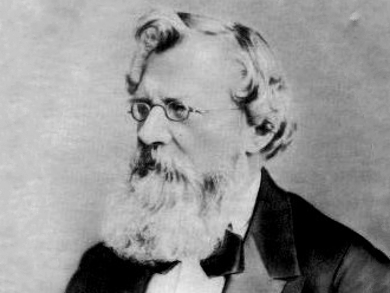August Wilhelm von Hofmann was born in Gießen, Germany, on April 8, 1818. He first studied law and languages at the University of Gießen, but then switched to studying chemistry under Justus von Liebig. He moved to London, UK, in 1845, where he became the first Director of the Royal College of Chemistry. Hofmann returned to Germany in 1865 and joined the University of Berlin. He held a position as Professor of Chemistry there until his death. He was co-founder and first President of the German Chemical Society (Deutsche Chemische Gesellschaft), founded in Berlin in 1867.
Hofmann made considerable contributions to organic chemistry. He was heavily influenced by Liebig and followed his example in fostering a chemistry education focusing on experimental work and industrial applications. Hofmann discovered the eponymous Hofmann rearrangement, which converts an amide to an amine, and the Hofmann elimination, which creates a tertiary amine and an alkene from a quaternary ammonium compound. Hofmann also systemized the study of organic amines and showed how they were related to ammonia.
Hofmann discovered the presence of aniline in coal tar, a waste product of the coal gas industry. A student of Hofmann, William Henry Perkin, discovered the first aniline dye, mauveine. This breakthrough provided the basis for the aniline dye industry. Hofmann also studied phosphorus bases, discovered allyl alcohol, and introduced “ball-and-stick” molecular models to public chemistry lectures.
Among many other honors, Hofmann was a Fellow of the Royal Society and received the Royal Medal from this society in 1854 and the Copley Medal in 1875. He was ennobled in 1888, adding the “von” to his name. August Wilhelm von Hofmann died on May 5, 1892, in Berlin.
August Wilhelm von Hofmann is the answer to Guess the Chemist (65).
Sources
- Bei den Briten abgeguckt,
Brigitte Osterath,
Nachr. Chem. 2017, 65, 157–160.
DOI: 10.1002/nadc.20174059217 - August Wilhelm Hofmann – “Reigning Chemist-in-Chief”,
Christoph Meinel,
Angew. Chem. Int. Ed. Engl. 1992, 31, 1265–1282.
DOI: 10.1002/anie.199212653 - August Wilhelm Hofmann (1818–1892),
Anthony S. Travis,
Endeavour 1992, 16, 59–65.
DOI: 10.1016/0160-9327(92)90003-8 - A. W. Hofmann and the founding of the Royal College of Chemistry,
John J. Beer,
J. Chem. Educ. 1960, 37, 248–251.
DOI: 10.1021/ed037p248
Selected Publications by August Wilhelm von Hofmann
- Zur Kenntniss des Coniins (in German),
A. W. Hofmann,
Ber. Dtsch. Chem. Ges. 1884, 17, 825–833.
DOI: 10.1002/cber.188401701222 - Ueber die Amide der Citronensäure; Umwandlung derselben in Pyridinverbindungen (in German),
A. Behrmann, A. W. Hofmann,
Ber. Dtsch. Chem. Ges. 1884, 17, 2681–2699.
DOI: 10.1002/cber.188401702211 - Ueber die Einwirkung des Broms in alkalischer Lösung auf Amide (in German),
A. W. Hofmann,
Ber. Dtsch. Chem. Ges. 1881, 14, 2725–2736.
DOI: 10.1002/cber.188101402242 - Researches on the Colouring Matters Derived from Coal-Tar. – II. On Aniline-Blue,
A. W. Hofmann,
Proc. R. Soc. London 1863, 13, 9–14.
DOI: 10.1098/rspl.1863.0005 - Notes of Researches on the Poly-Ammonias. – No. XX. On the Colouring Matters Produced from Aniline,
A. W. Hofmann,
Proc. R. Soc. London 1862, 12, 1–13.
DOI: 10.1098/rspl.1862.0001 - Untersuchungen über die Phosphorbasen (in German),
A. Cahours, A. W. Hofmann,
Ann. Chem. Pharm. 1857, 104, 1–39.
DOI: 10.1002/jlac.18571040102 - Notes of Researches on the Poly-Ammonias. – No. V. Action of Bichloride of Carbon on Aniline,
A. W. Hofmann,
Proc. R. Soc. London 1857, 9, 284–286.
DOI: 10.1098/rspl.1857.0067 - Beiträge zur Kenntniss der flüchtigen organischen Basen (in German),
A. W. von Hofmann,
Ann. Chem. Pharm. 1849, 70, 129–149.
DOI: 10.1002/jlac.18490700202 - Ueber das Styrol und einige seiner Zersetzungsproducte (in German),
John Blyth, Aug. Wilh. Hofmann,
Ann. Chem. Pharm. 1845, 53, 289–329.
DOI: 10.1002/jlac.18450530302 - Neue Bildungsweisen des Anilins (in German),
J. S. Muspratt, A. W. Hofmann,
Ann. Chem. Pharm. 1845, 53, 221–229.
DOI: 10.1002/jlac.18450530206
Also of Interest




